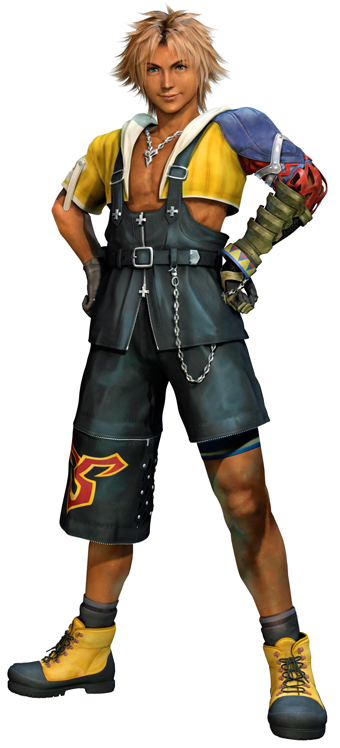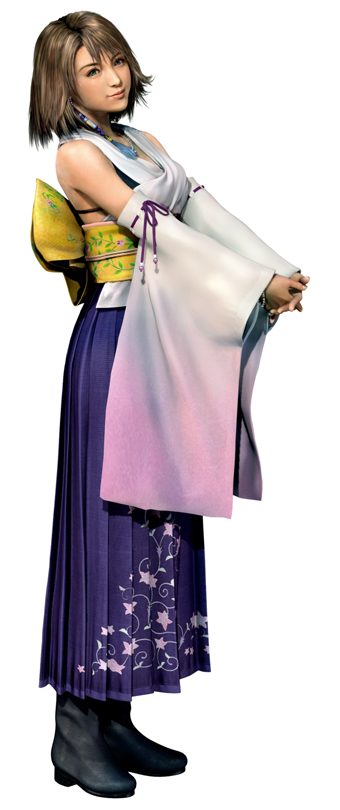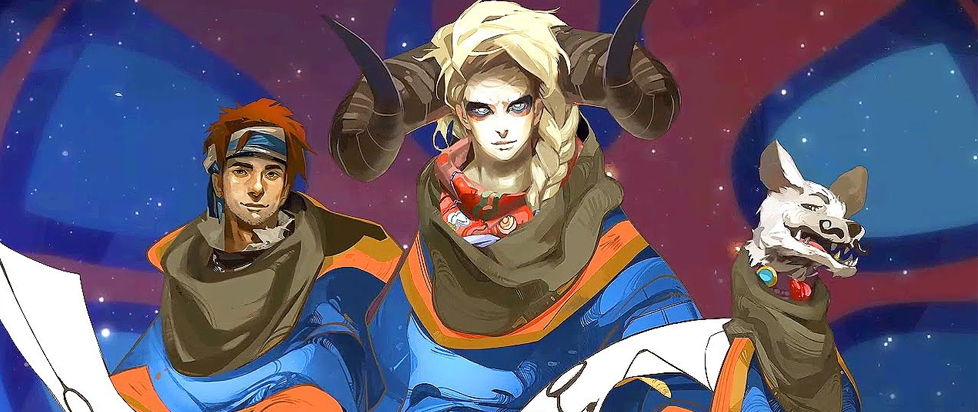Final Fantasy X-Ray: It’s Stories All the Way Down
Final Fantasy X begins near the end, with the camera slowly panning across a group of people gathered around a campfire. They sit in silence while, on the horizon, the sun sets over their dreaded destination. As the camera moves from person to person, one stands and moves to comfort another. For the first time, we see a character’s face close-up. Yuna. Then the camera cuts away – it’s Tidus who has stood up, who walks away from the others, and begins to speak.
Final Fantasy was, since its inception, a series of videogames devoted to storytelling above all other considerations and the developers outdid themselves with Final Fantasy X, a game whose narrative is about narrative. It’s a game about stories, Tidus’ and Yuna’s, who are both protagonists but never at the same time, whose roles in their respective narratives, more than any other tragedy of circumstance, is what keeps them apart.
That moment on the hill overlooking Zanarkand, when Tidus says “Listen to my story,” is the moment that his story ends. From there on out, it’s Yuna’s story.
“Listen to my story,” he says, as the camera slowly pans away from him.
But it’s not his story. Not at that moment. Not anymore.
 Tidus’ Story
Tidus’ Story
There are many theories and methods of narrative creation, but one of the best-documented is a process called Dramatica. Dramatica is a theory of narrative construction that can be used to break down nearly any story. According to Dramatica’s formula, a good story must consist of four smaller story arcs. TVTropes summarizes them as thus:
The Overall Story, which is the main plot arc (for example, in [the movie] Spider-Man 2, Spider-Man is trying to stop Doctor Octopus).
The Main Character’s Story, which is the dramatic arc of the main character (for example, Peter Parker is losing control of his powers due to the stress of balancing his superhero side and his everyday life).
The Impact Character’s Story, which is the Impact Character’s dramatic arc (for example, Mary Jane’s attempts to get closer to Peter while pursuing her own dreams).
The Main vs. Impact Story, which covers the struggles of the Main and Impact character as they seek to influence each other (for example, Peter Parker struggling to meet his commitments while Mary Jane pulls away).
If we apply this to Tidus’ story – the one he tells, consisting of the flashback that takes up most of the game’s length, from the second cutscene until the moment that the player catches up chronologically with the first – we get the following:
The Overall Story: Tidus is trying to return home to Zanarkand.
The Main Character’s Story: Tidus’ character growth, from a self-centered celebrity to a caring and selfless hero.
The Impact Character’s Story: Yuna’s pilgrimage to Zanarkand to defeat Sin.
The Main vs. Impact Story: Tidus and Yuna’s budding but forbidden love.
Tidus is the protagonist, Jecht is the antagonist and Yuna is his impact character – in Tidus’ story, at least. Can we say the same for Final Fantasy X as a whole? In the game’s first act, Tidus is cheerfully pressing forward with a mission that will, unbeknownst to him, be the death of Yuna. In the second act, it is Yuna who is pressing obliviously forward with a mission that will mean Tidus’ “death.” What’s more, we’ve learned that Tidus himself is a fiction, even in the fiction of the Final Fantasy X world, and will disappear as soon as Yu Yevon’s story ends. What happened?
The transition from Tidus to Yuna begins, fittingly enough, at the place called Home, where Tidus realizes that Yuna’s pilgrimage is supposed to end in her death. By the time Tidus learns of his own impending death, on the outskirts of his former home Zanarkand, the transition is complete: though we, the player, are still walking around in Tidus’ body – most of the time, at least – Tidus’ story is effectively over and Final Fantasy X has shifted its focus almost entirely to Yuna’s.
There is one moment that the two stories fully intersect, when Tidus and Yuna share the protagonist’s place. Fittingly, it is also the scene of their one romantic tryst: the “suteki da ne” scene, in Macalania Woods. Bookended by the two discoveries that marked the beginning and end of the transition from Tidus-as-protagonist to Yuna-as-protagonist, this moment breaches the narrative conventions that have been set up thus far in the game in order to create a ‘safe space’ of sorts. For one, the scene is entirely non-playable, a significant artistic decision in a videogame because it means that the player has no role or control, that the player has been removed from the narrative equation. It’s the closest that Tidus and Yuna come to possessing agency. Further, in this game about stories, the “suteki da ne” scene is a moment of pure fantasy: hidden away from their respective narrative responsibilities, Tidus and Yuna allow themselves to believe in a happy ending that both know is impossible.
 What moves me about the “suteki da ne” scene is that it’s a moment where the stories that these characters live by are rolled away but, in that absence, a new story takes its place, a story of ridiculous, fantastical impossibility even in the parameters of this fictional world of Spira. And yet it feels honest – honest and personal and ‘real’ in a way that the game never quite recaptures.
What moves me about the “suteki da ne” scene is that it’s a moment where the stories that these characters live by are rolled away but, in that absence, a new story takes its place, a story of ridiculous, fantastical impossibility even in the parameters of this fictional world of Spira. And yet it feels honest – honest and personal and ‘real’ in a way that the game never quite recaptures.
But the moment ends, and after this scene Tidus’ story enters its denouement. By the time Tidus learns his true identity on Mount Gagazet, his story is effectively over, and it has ended because he himself is a character in the story woven by the villain, Yu Yevon.
“Listen to my story,” Tidus says at the encampment on the edge of Zanarkand. “It may be our last chance.” And it is, because by that time Tidus’ story arc has ended, and he knows it. Though we, the player, still use his body as the vehicle through which to move through the world, it’s Yuna’s story that has become forefront in Final Fantasy X. In the story of Yuna’s pilgrimage, it’s Yuna that holds the role of protagonist and her antagonist is Yu Yevon’s story, the fiction he created to punish Spira for his defeat. Tidus, in Yuna’s story, is just the impact character – even his antagonist, Jecht, has been literally and figuratively subsumed by Yuna’s Yu Yevon.
The Overall Story: Yuna’s pilgrimage to Zanarkand to defeat Sin.
The Main Character’s Story: Yuna’s character growth, from a naïve and helpless sacrifice to a leader.
The Impact Character’s Story: Tidus’ attempts to return home to Zanarkand.
The Main vs. Impact Story: Tidus and Yuna’s budding and forbidden love, an increasingly problematic influence in both their missions.
The Dramatica process still gives us a way to reconcile these two stories, however. It recognizes a difference between the “external story” of protagonist versus antagonist and the “emotional story” of viewpoint character versus impact character. This sort of division helps explain stories like To Kill a Mockingbird, where Atticus Finch is the protagonist but his daughter Scout is the viewpoint character. From this paradigm, we can assign Yuna the role of protagonist and Yu Yevon the role of antagonist, and Tidus the role of viewpoint character with Yuna as his impact character.
This is how Final Fantasy X reads using Dramatica’s theories, but Final Fantasy X demands more than a reading. It’s a game, no matter how linear or narrative-driven, which means we have to make room for the player in our determinations of narrative roles. For example, Tidus doesn’t quite fit the role of ‘viewpoint character’ according to Dramatica, because it’s not Tidus we’re role-playing as, even though his body is the player’s vehicle through Final Fantasy X, at least more consistently than the other five party members. No, Tidus isn’t like the Final Fantasy protagonists that preceded him. He’s more fleshed out, more character than avatar. That makes him less than Cloud and Squall and Terra and the others, insofar as their blankness gives them exponential possibilities of self through the players who play them.
A character is smaller than an avatar, but it’s this smallness that lets both Tidus and Yuna fit into the role of protagonist for Final Fantasy X. And we the player are neither of them, though we play as both at different instances throughout the story. Instead of role-playing as a character in the story, the player of Final Fantasy X is role-playing as reader, as audience. Role-playing as player.
Zoom out enough to take in the entirety of this enormous playable database called Final Fantasy X, and the diagram changes once again. Here, the player is the main character. Because, unlike other Final Fantasy games, there wasn’t room for a player in Tidus, or in Yuna. The player remains outside of them, as the main character in this story of stories. The Dramatica diagram of Final Fantasy X looks like this:
The Overall Story: A player guides and levels up seven characters, ensuring that they survive every challenge placed before them.
The Main Character’s Story: The player’s interaction with seven characters, particularly Tidus and Yuna.
The Impact Character’s Story: Tidus and Yuna’s growing romance as they each struggle with their specific antagonists and plotlines.
The Main vs. Impact Story: Under the player’s hand, Tidus comes to grips with his identity as a character in a story, ultimately submitting his control to Yuna, who ends the game (and begins the sequel) as the player’s new vessel.
Final Fantasy has always been a self-aware series – the first game was so named because Hironobu Sakaguchi thought it would be the last game that his struggling studio would be able to create. Since then, most of the main characters have struggled with fantasies themselves, from Cloud’s false memories to Zidane’s synthetic origins. But with FFX they pushed the envelope further than ever before. Final Fantasy X is a game where even the stories have stories, where each character has his or her own final fantasy, where stories are the difference between life and death in more than one way, and where we, the player, are audience to them all, the disembodied force who moves through the stories that comprise the game, just as we do with the stories that comprise our lives.
———
Follow Jill Scharr on Twitter @JillScharr.





